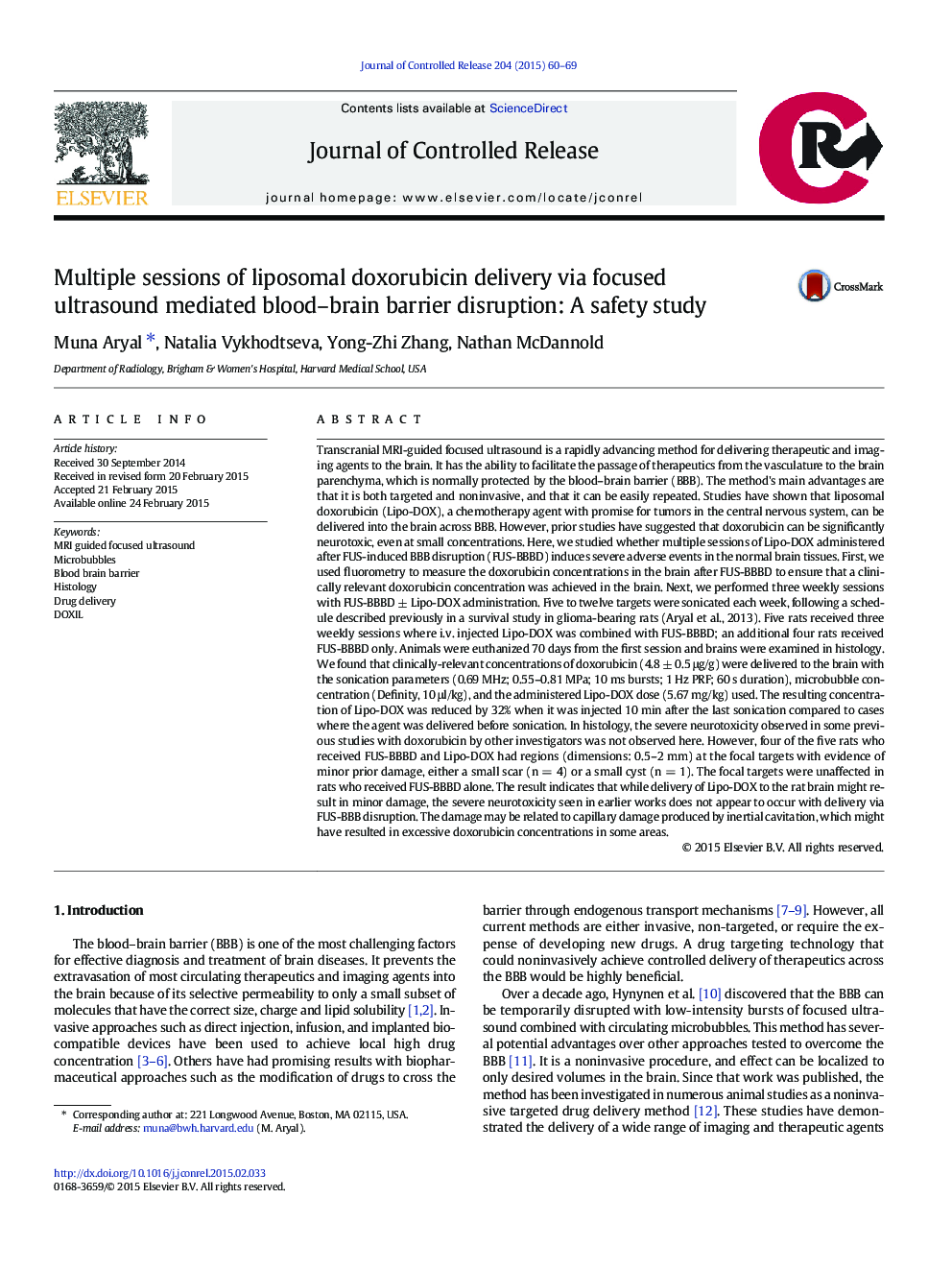| کد مقاله | کد نشریه | سال انتشار | مقاله انگلیسی | نسخه تمام متن |
|---|---|---|---|---|
| 1423790 | 1509045 | 2015 | 10 صفحه PDF | دانلود رایگان |
Transcranial MRI-guided focused ultrasound is a rapidly advancing method for delivering therapeutic and imaging agents to the brain. It has the ability to facilitate the passage of therapeutics from the vasculature to the brain parenchyma, which is normally protected by the blood–brain barrier (BBB). The method's main advantages are that it is both targeted and noninvasive, and that it can be easily repeated. Studies have shown that liposomal doxorubicin (Lipo-DOX), a chemotherapy agent with promise for tumors in the central nervous system, can be delivered into the brain across BBB. However, prior studies have suggested that doxorubicin can be significantly neurotoxic, even at small concentrations. Here, we studied whether multiple sessions of Lipo-DOX administered after FUS-induced BBB disruption (FUS-BBBD) induces severe adverse events in the normal brain tissues. First, we used fluorometry to measure the doxorubicin concentrations in the brain after FUS-BBBD to ensure that a clinically relevant doxorubicin concentration was achieved in the brain. Next, we performed three weekly sessions with FUS-BBBD ± Lipo-DOX administration. Five to twelve targets were sonicated each week, following a schedule described previously in a survival study in glioma-bearing rats (Aryal et al., 2013). Five rats received three weekly sessions where i.v. injected Lipo-DOX was combined with FUS-BBBD; an additional four rats received FUS-BBBD only. Animals were euthanized 70 days from the first session and brains were examined in histology. We found that clinically-relevant concentrations of doxorubicin (4.8 ± 0.5 μg/g) were delivered to the brain with the sonication parameters (0.69 MHz; 0.55–0.81 MPa; 10 ms bursts; 1 Hz PRF; 60 s duration), microbubble concentration (Definity, 10 μl/kg), and the administered Lipo-DOX dose (5.67 mg/kg) used. The resulting concentration of Lipo-DOX was reduced by 32% when it was injected 10 min after the last sonication compared to cases where the agent was delivered before sonication. In histology, the severe neurotoxicity observed in some previous studies with doxorubicin by other investigators was not observed here. However, four of the five rats who received FUS-BBBD and Lipo-DOX had regions (dimensions: 0.5–2 mm) at the focal targets with evidence of minor prior damage, either a small scar (n = 4) or a small cyst (n = 1). The focal targets were unaffected in rats who received FUS-BBBD alone. The result indicates that while delivery of Lipo-DOX to the rat brain might result in minor damage, the severe neurotoxicity seen in earlier works does not appear to occur with delivery via FUS-BBB disruption. The damage may be related to capillary damage produced by inertial cavitation, which might have resulted in excessive doxorubicin concentrations in some areas.
Figure optionsDownload high-quality image (173 K)Download as PowerPoint slide
Journal: Journal of Controlled Release - Volume 204, 28 April 2015, Pages 60–69
